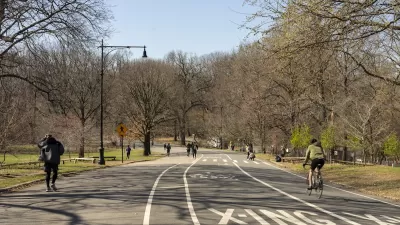Once scratchy and unrealistic, artificial grass has come a long way. Now, it’s quickly becoming a popular lawn replacement as droughts and climate change make traditional lawns harder to maintain.

Writing in Bloomberg CityLab, Brian Eckhouse and Siobhan Wagner describe the movement to replace suburban grass lawns with artificial turf in cities facing worsening drought and water restrictions. “Within the next 30 years, droughts may impact three quarters of the world’s population. While plastic turf poses its own climate challenges, it’s increasingly seen as a viable alternative to real green yards that devour precious water.”
Homeowners are taking notice. “For some, it’s the cash-for-grass rebates being offered by local water agencies. For others, it’s the realization that the classic lawn is increasingly unsustainable in a time of megadrought. And then there are the residents coaxed into the shift by the water notices or fines.”
Critics of artificial turf say some types, made of recycled tires, can leach chemicals into the ground and waterways. “The most obvious environmental problem with artificial grass is it’s rooted in the biggest climate nemesis of all: fossil fuel. Synthetic turf is made from a stew of petroleum-based components, making it nearly impossible to recycle. At the end of an artificial lawn’s useful life, which is about 15 years, it will likely go to a landfill or be incinerated.”
Comparing the products to plastic water bottles, “Stefan Diderich, director general of the EMEA Synthetic Turf Council, an artificial grass industry group, says companies are trying to develop a more widely recyclable turf made from a single material like polyester.”
As climate change shifts weather patterns around the world, “The future for lawns is in question everywhere. Even in the UK—a country synonymous with rain—lawn owners are accepting shades of yellow and brown amid green.”
FULL STORY: The Suburban Lawn Will Never Be the Same

Maui's Vacation Rental Debate Turns Ugly
Verbal attacks, misinformation campaigns and fistfights plague a high-stakes debate to convert thousands of vacation rentals into long-term housing.

Planetizen Federal Action Tracker
A weekly monitor of how Trump’s orders and actions are impacting planners and planning in America.

San Francisco Suspends Traffic Calming Amidst Record Deaths
Citing “a challenging fiscal landscape,” the city will cease the program on the heels of 42 traffic deaths, including 24 pedestrians.

Adaptive Reuse Will Create Housing in a Suburban Texas Strip Mall
A developer is reimagining a strip mall property as a mixed-use complex with housing and retail.

Study: Anti-Homelessness Laws Don’t Work
Research shows that punitive measures that criminalized unhoused people don’t help reduce homelessness.

In U.S., Urban Gondolas Face Uphill Battle
Cities in Latin America and Europe have embraced aerial transitways — AKA gondolas — as sustainable, convenient urban transport, especially in tricky geographies. American cities have yet to catch up.
Urban Design for Planners 1: Software Tools
This six-course series explores essential urban design concepts using open source software and equips planners with the tools they need to participate fully in the urban design process.
Planning for Universal Design
Learn the tools for implementing Universal Design in planning regulations.
Heyer Gruel & Associates PA
JM Goldson LLC
Custer County Colorado
City of Camden Redevelopment Agency
City of Astoria
Transportation Research & Education Center (TREC) at Portland State University
Jefferson Parish Government
Camden Redevelopment Agency
City of Claremont




























